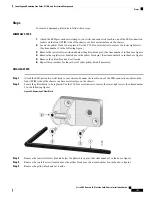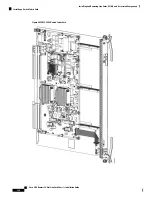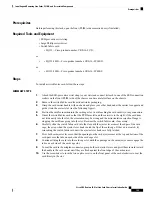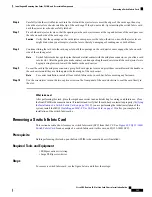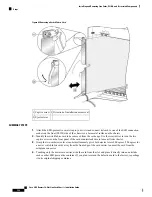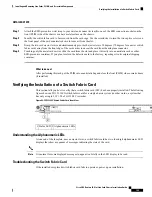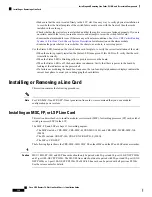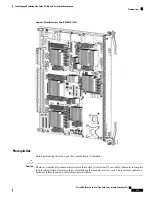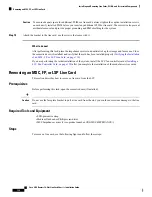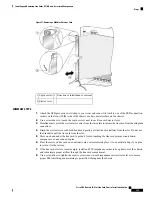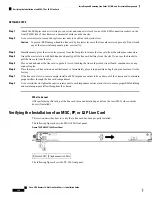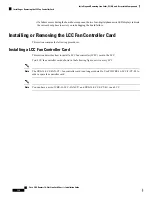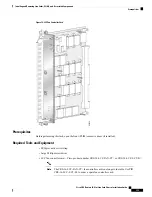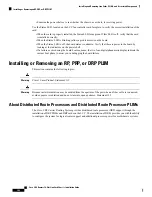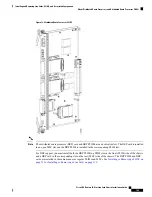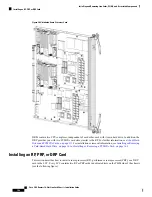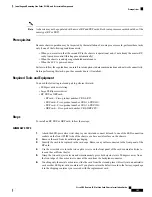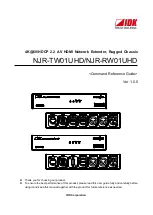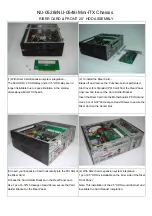
SUMMARY STEPS
1.
Attach the ESD-preventive wrist strap to your wrist and connect its leash to one of the ESD connection
sockets on the front (PLIM) side of the chassis or a bare metal surface on the chassis.
2.
Choose an available modular services card slot for the line card.
3.
Remove the MSC impedance carrier from the slot you need to fill and set it aside.
4.
Remove the replacement line card from the antistatic bag or mat.
5.
Use both hands while inserting a line card. Use one hand on the faceplate and the other hand along the
base of the line card to guide it into a slot.
6.
Orient the line card so that the PCB faces left and the carrier is to the right; if the card does not slide
easily into the slot, the orientation may be wrong and the misorientation rejection flange is stopping the
card from going into the slot. Reorient the line card, if necessary.
7.
Make sure that the ejector levers are oriented properly to engage with the pin as the line card slides into
the slot. Carefully slide the line card into the slot until the ejector levers engage the catches, then
stop.
8.
Simultaneously pivot the ejector levers toward the faceplate of the line card. Do not force the line card;
the ejector levers properly seat the line card against the midplane.
9.
Use a screwdriver to tighten the captive screws next to each line card ejector lever to ensure proper EMI
shielding and prevent the line card from becoming partially dislodged from the midplane.
10.
Attach the bracket to the line card; use the screws that came with it.
DETAILED STEPS
Step 1
Attach the ESD-preventive wrist strap to your wrist and connect its leash to one of the ESD connection sockets on the
front (PLIM) side of the chassis or a bare metal surface on the chassis.
Step 2
Choose an available modular services card slot for the line card.
To prevent ESD damage, handle a modular services card by its ejector levers or the line card carrier edges
only. Do not touch any of the electrical components, pins, or circuitry.
Caution
Step 3
Remove the MSC impedance carrier from the slot you need to fill and set it aside.
Remove only one impedance carrier and install one line card at a time. Be sure to verify that each line card
is fully installed and secured before installing another card.
Note
Step 4
Remove the replacement line card from the antistatic bag or mat.
Step 5
Use both hands while inserting a line card. Use one hand on the faceplate and the other hand along the base of the line
card to guide it into a slot.
Step 6
Orient the line card so that the PCB faces left and the carrier is to the right; if the card does not slide easily into the slot,
the orientation may be wrong and the misorientation rejection flange is stopping the card from going into the slot.
Reorient the line card, if necessary.
Step 7
Make sure that the ejector levers are oriented properly to engage with the pin as the line card slides into the slot. Carefully
slide the line card into the slot until the ejector levers engage the catches, then
stop.
Step 8
Simultaneously pivot the ejector levers toward the faceplate of the line card. Do not force the line card; the ejector
levers properly seat the line card against the midplane.
If the captive screws are difficult to tighten, ensure that each ejector lever is properly secured to each catch
and that the line card is properly seated in the slot.
Note
Step 9
Use a screwdriver to tighten the captive screws next to each line card ejector lever to ensure proper EMI shielding and
prevent the line card from becoming partially dislodged from the midplane.
Cisco CRS Routers 16-Slot Line Card Chassis Installation Guide
133
Installing and Removing Line Cards, PLIMs, and Associated Components
Steps



